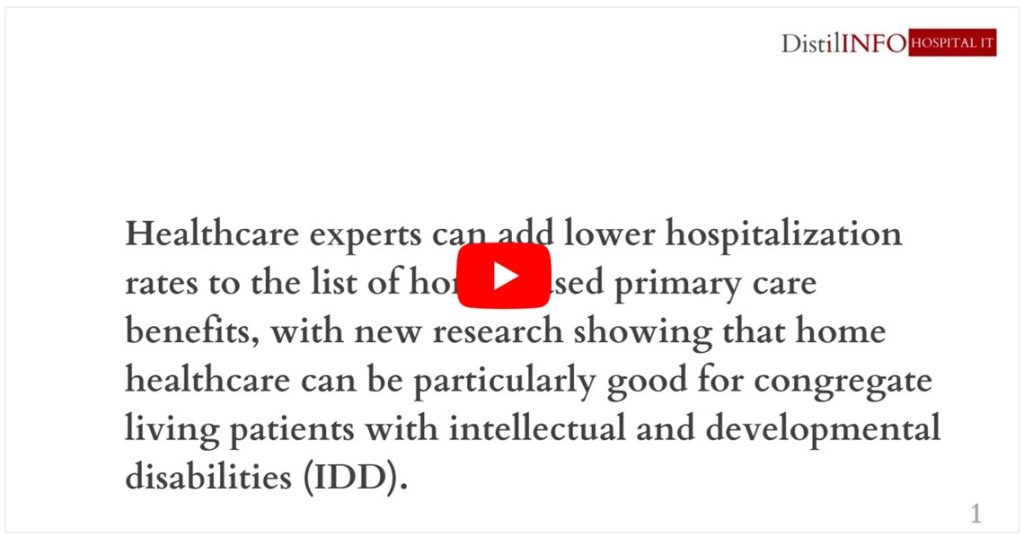
Healthcare experts can add lower hospitalization rates to the list of home-based primary care benefits, with new research showing that home healthcare can be particularly good for congregate living patients with intellectual and developmental disabilities (IDD).
The data, published in the Journal of the American Medical Directors Association, showed a statistically significant lower hospital utilization rate for folks who had access to home-based primary care, which consisted of home care visits every five weeks and 24/7 access to primary care providers. This is on top of the patient satisfaction benefits already associated with home-based healthcare, the researchers said.

“These findings further confirm our belief that HBPC is an important care model for organizations caring for IDD patients and can be critical to enhancing outcomes for this complex patient population,” study author William Mills, MD, senior vice president of medical affairs for BrightSpring Health Services, a home-based primary care organization, said in a press release.
The researchers looked at 757 patients with IDD between April 2020 and February 2022, creating an intervention study group of 207 individuals who elected to receive home-based primary care. Those in that intervention group had 24/7 access to in-house primary care physicians and advanced practice providers. They also had a home-based primary care visit every five weeks.
Those in the control group received regular access to primary care approximately every 12 months and outside of their residential settings. Ultimately, those in the control group were more likely to have a hospital admission than those in the intervention group.
The overall hospitalization rate for the intervention group was 329 hospitalization per 1,000 patients, compared to a hospitalization rate of 619 hospitalizations per 1,000 patients among the usual care cohort.
This reduced hospitalization rate could be the byproduct of the many benefits home-based primary care brings, the researchers said. The patients in the intervention group had 24/7 access to medical triage, which may have steered many from accessing high-acuity care like the emergency department, for example.
Home-based primary care also brings with it more comprehensive primary care that can lead to early disease detection, care coordination, and goal setting. Visiting the patient in the context of their own home—in this case, the congregate living setting—also has its benefits. Patient satisfaction and relationship-building with their clinicians may improve, the researchers posited, while clinicians may better detect social determinants of health affecting wellness.
These findings are a little skewed, the researchers acknowledged, because the intervention group was determined by patient election—patients opted into home-based primary care, a choice the study authors said may have been influenced by patient health status. Specifically, the researchers initially hypothesized the self-selected intervention group might have baseline poorer health outcomes as measured by hospitalization rates.
But further analysis showed the opposite.
“In fact, at baseline, patients who eventually opted for HBPC had approximately one-third of the hospitalization rate of the group receiving HBPC,” the researchers wrote in the study’s discussion.
“What caused this baseline difference is uncertain, but potential factors include the following,” they added, “patients or responsible parties and care team members may have already implemented care plans focused on reducing avoidable hospital admissions, they may have been cared for by primary care providers who were more responsive and engaged than those of the control group, or other congregate living setting–specific factors.”
The benefits to patients with IDD living in congregate care settings are not to be ignored, the researchers added. People with IDD are more likely to have multiple chronic illnesses, meaning they likely have more complex medical needs. Moreover, visiting high acuity care sites like the hospital or emergency department can be particularly distressing for this population.
This study provides insight into ways the medical industry can reimagine long-term care and disease management for folks with complex needs in congregate living settings, the researchers said.
“The results of this latest study are very significant, and they further demonstrate our commitment to improve care for IDD patients across the board with new and person-centered care practices,” Jon Rousseau, president and CEO of BrightSpring, said in a statement. “We look forward to continuing to leverage novel and important approaches and study data to ensure the highest standard of care for the individuals we support, as well as other complex patient populations nationwide.”
Source: Patient Engagement HIT

Leave a Reply